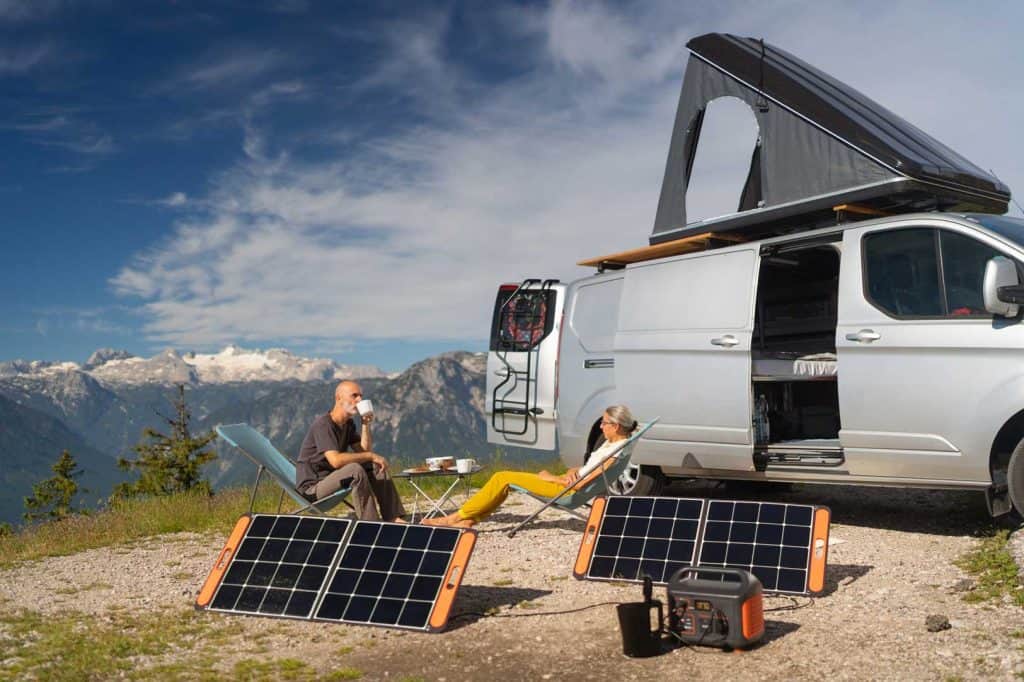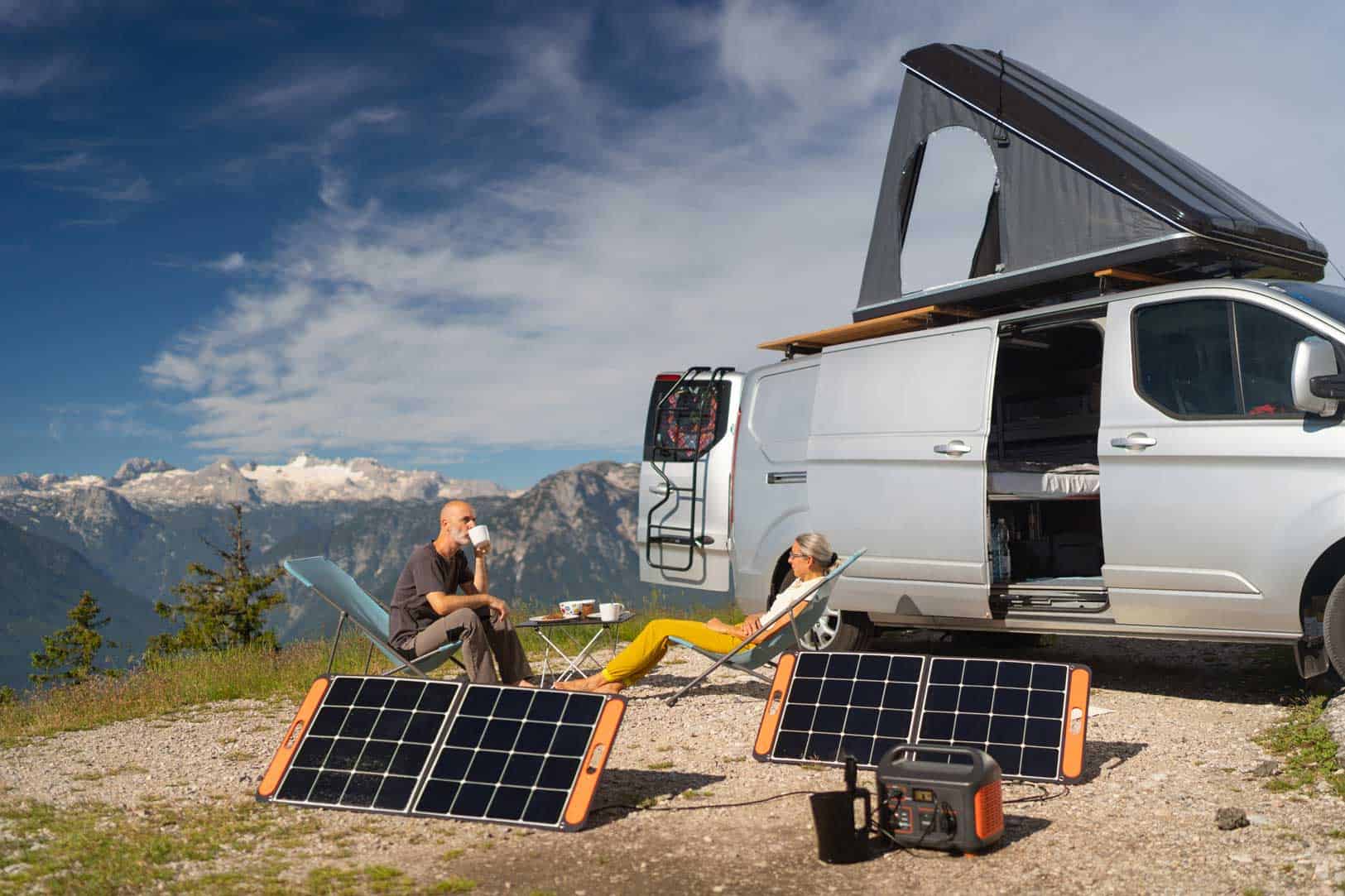Solar energy offers tremendous benefits to the regular campers and especially boondockers: clean, quiet electricity and independence from fuel, which opens up endless travel opportunities.
You will also enjoy considerable savings in the long term, but it requires an initial investment.
Find out how much does it cost to install solar panels on an RV depending on your power demand and see if you can afford to go sustainable. At the end of this article, you will find a step by step guide on how to install solar panels on RV.
How Much Does It Cost To Install Solar Panels On An RV
Professional Installation Cost
If you want to have a professional install your solar system for you, expect to pay between $100 and $150 per hour. A small and thus less complicated installation might take some 2-3 hours.
Meanwhile, a large and more complicated setup, for instance one with a dozen panels wired in series or parallel plus more than one charge controller, can easily take from 10 up to 15 hours, sometimes a bit more. In short, RV solar installation cost will cost some $300 to north of $2,000.
Solar Panel Price & DIY Installation Cost
Most solar panels for RV on the market have a power output of between 100 and 400 watts of power per panel. Solar panels for RV cost between $50 and $300 for a single panel, depending on the power output as well as the type and material.
Monocrystalline solar panels are the most advanced and are capable of the highest power output, thus are the most expensive, followed by polycrystalline and then flexible amorphous panels.
The number of solar panels and the total wattage rating you need depends on your daily power consumption. An small sized RV, that is a Class B minivan or a small travel trailer, typically consumes about 120 watts to 200 watts of power per hour.
Meanwhile, a medium to large sized RV, including Class A and Class C RVs and larger trailers and fifth wheels, on average draw about 450 watts per hour.
This means a DIY RV solar panel installation will cost you at least $600 for the simplest setup up to some $2,000 for more extensive systems for above-average power demand.
How to Estimate Your Wattage Demand
If you want to only pay for what you need and be precise with estimating the wattage rating your solar system should have, you will need to calculate your average daily power consumption.
Charging House Battery
For instance, you only need a small solar system to top off your deep cycle house battery. Let’s say your 12 volt battery bank has a capacity of 200AH; this rating means this battery can supply 200 amp-hour of power per day during a period of 20 hours, which is the standard available use. Divide 200 amp-hour by 20 hours, we get the amp rating of the battery, which is 10 amps.
This battery must be charged at 10 amps and 12 volts, which means if you intend to recharge this battery with solar panels, your system must be capable of at least: 10 amps x 12 volts = 120 watts of power.
When it comes to your precious house battery, always go up to the next common size to stay on the safe side. This means you need at least two 100-watt solar panels to get a total capacity of 200 watts.
Wattage Demands of Motor-Driven Electronics
Otherwise, you may need to power a number of electrical appliances. To estimate your average daily power consumption, you will need to add up the “starting wattage” of all the electronics that you often use, which can be found on their nameplate.
Electronics with electric motors, like fridges and microwave ovens, would have a running wattage and a starting wattage, and do note that the starting wattage is typically much higher than the running wattage. This is because more power is required to get the motor up and running, while maintaining operation is less demanding.
For instance, a 13,500 BTU air conditioner typically needs 2,900 starting wattage and 1,300 running wattage. An RV microwave convection oven needs only 200 to 600 watts of running wattage, but requires up to 2,200 watts for starting up. Let’s say these are the two major appliances that you need to power daily, plus some LED lights and a router that do not consume a lot of power.
In this case, you would need at least: 2,200W + 2,900W = 5,100W worth of solar panels. Let’s round it up to at least 600 watts to account for your LED lights and the remaining devices, and add a 20 percent safety cushion, which brings the total to 800 watts.
Related: Can Solar Panels Power an RV Air Conditioner?
Wattage Demands of Non-Motor Electronics
In case of an appliance that does not rely on a motor, look for its voltage and current demands on the nameplate. For instance, you have a portable 12 volt RV fridge that lists 120 volts and 5 amps.
The fridge’s wattage draw would be: 120 volts x 5 amps = 600 watts of power per hour. For the sake of simplicity, let’s say this fridge is the only thing you want to keep powered using solar panels. Then your system must be capable of at least 600 watts, or 800 watts after adding a 20 percent safety cushion.

How to Install Solar Panels on an RV
Safety Guidelines
- RV solar panels installation is best done in dry weather, and ideally on a cloudy day when there’s little to no direct sunlight to prevent the panels becoming charged during installation
- If there’s direct sunlight, it’s important to keep the panels in the boxes that they came in or cover them
- Once the panel is exposed to light, avoid touching terminals and other electrically active components.
Step 1: Secure The Solar Panels on Your RV Roof
- Flexible panels can be mounted with adhesive only, while rigid panels come in mounting brackets that must be screwed onto the studs on your roof.
- Mark where you want to mount the panels on the roof to make sure everything fits. Make sure no externally mounted devices like a satellite dish might cast shade over the panels.
- Attach the panels to the frame or mounting brackets and mark where you need to drill holes. Note that flexible panels can be mounted with adhesive only, while rigid panels come in mounting brackets that must be screwed onto the studs on your roof. The studs are usually visible with a 2 to 3 inches wide gray line going width wise on your roof.
- Drill small pilot holes and fill them with sealant to create a water-tight seal. Check with your RV manufacturer which type of adhesive is required for your specific roof membrane material.
- Screw the panels in.
- For extra weatherproofing capability, you can apply a generous coat of protective sealant on top and around the mounting brackets to seal everything off.
Step 2: Connect The Solar Panels Together
- If your setup has more than one solar panel, you will need to connect them either in series or parallel, depending on whether you need more amperage or voltage.
- In series: Wire your panels in series if you want more voltage. Connect the positive terminal of the first panel to the negative terminal on the next, and so on. The remaining negative terminal of the first panel and the remaining positive terminal of the last panel in the array will then be connected to the RV solar charge controller.
- In parallel: Wire your panels in parallel if you want more amperage. Connect all of the positive terminals together and all the negative terminals together. Connect the positive terminal of the first panel to the positive terminal of the charge controller, then connect the positive terminal of the last panel to the positive terminal of the charge controller. Then do the same for the negative terminals of the first panel and the last panel.
- In series + parallel: A series-parallel setup is multiple series that you wire in parallel to get more amperage as well as voltage. For instance, if you have four panels, wire two panels in series to form two pairs, then wire these two pairs in parallel.
Step 3: Run The Wirings From The Roof To Inside The RV
There are a few ways to run the power cable from the solar panels on the roof into the RV to where the charge controller is:
- The most simple drill-free method is to run the wirings through the existing refrigerator vent.
- The charge controller must be close to the battery compartment. If the refrigerator vent is not conveniently located, run the wirings through the plumbing pipe.
- The last resort is to drill a hole wherever you need it. Try to drill near a cabinet or interior wall so you can hide the wire from sight. Then apply a generous amount of sealant around any drilled holes to weatherproof it.
Step 4: Connect The Charge Controlled
- To minimize line loss, mount the charge controller to the wall as close to your batteries as possible, but still a safe distance away from heat and corrosive gasses.
- Connect the charge controller to the battery first, then to the solar panels with the power cables that you previously ran to inside the RV. This way, as soon as you connect the charge controller to the solar panels, the charge from the panels will run to the battery.
Step 5: Connect The Inverter
This is optional, since you only need to connect the inverter if your RV has AC appliances like the microwave. The inverter converts DC power generated by the solar panels to AC power.
- Mount the inverter near the batteries, again away from heat and corrosive battery gasses.
- Connect the negative terminal of your inverter to the negative terminal of your house battery first, then connect the positive terminals.

